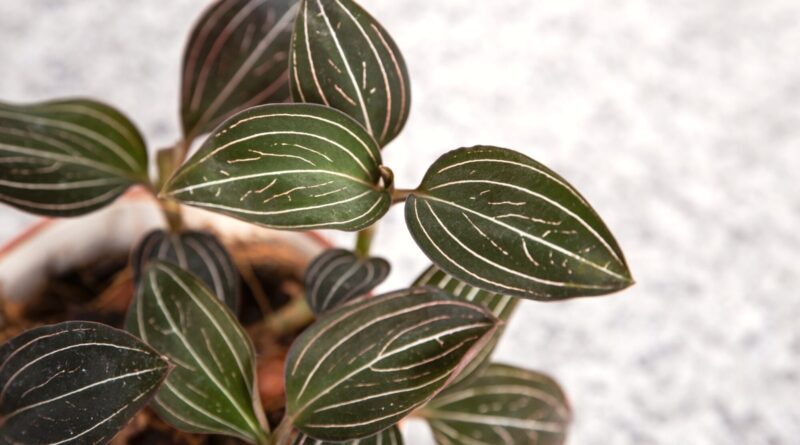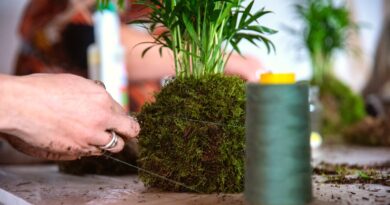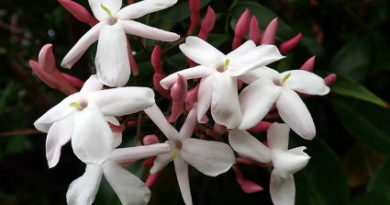How to Plant, Grow, and Care for Ludisia Orchids
Ludisia is a small orchid genus of only two species. They are prized more for their attractive foliage than their flowers. It is a flowering orchid; however, the blooms are smaller and less showy than most orchids.
Commonly referred to as Jewel orchids, they have different growth habits than most of their relatives, which makes their care different. This can be challenging for even the experienced orchid cultivator. With a little guidance, though, Ludisia orchids can be easy to care for and fast propagators.
Ludisia Orchid Overview

|
|
|
|
History

Originally described in 1818, Ludisia orchids were thought to have been discovered in Brazil, and the name Goodyera discolor was assigned to the species. The name was changed to Ludisia in 1825, with the correction published by the Kew Center in their 1870 bulletin.
The true origin of Ludisia discolor orchids is Asia, where they are found in Malaysia, Indochina, China, Indonesia, and several other adjacent countries. This orchid is particularly prolific in Malaysia. The genus was considered monotypic for a long time, with only one named species. It wasn’t until 2013 that a second species, Ludisia ravanii, was described and discovered in the Philippines.
Native Area

Ludisia ravanii, the newly discovered species, is solely native to the Philippines. The originally discovered Ludisia discolor originates in Southern China, Vietnam, Malaysia, Indonesia, Myanmar, the Philippines, Thailand, and Northern India. These orchids are low-growing and can be found on tropical and subtropical forest floors.
Characteristics

Ludisia orchids are a bit of a surprise in the orchid cultivation world. Where most orchids are epiphytic or lithophytic, Ludisia orchids are terrestrial or ground growers. They are similar to Spathoglottis orchids in terms of their soil and moisture needs but are far less tolerant of sun exposure than other terrestrial orchids. In terms of care, they are most similar to Macodes orchids.
These orchids, like most others, are perennial evergreens. They do not lose their leaves the way a deciduous plant does. Instead, they retain their foliage year-round. They bloom once per year and can live for many years, so they are considered long-lived perennials.
Ludisia orchids bloom once per year. Their blooming season is usually in winter, as the cooling weather initiates flower development. When kept as houseplants, though, they can bloom at any time of year. The flower stems are tall and thin and produce small white flowers, which most consider unremarkable, although pretty.
These orchids are best known for their attractive foliage. They are sympodial orchids, so they spread horizontally along a central rhizome, sending up pseudobulbs that produce their lovely leaves. They can grow to great lengths along the forest floor but rarely grow taller than eight inches.
The prized foliage is striking and, in most cases, is a deep red color underneath with a darker, greener tint to the top of the leaves. It is their distinctive and bold veining that sets these orchids apart. The tops of the leaves also have a shimmery quality and texture.
Uses

Ludisia, like most orchids, are cultivated almost exclusively for their ornamental value. They are beautiful plants and quite collectible, as any orchid enthusiast knows. This beautiful and less widely available type of orchid tends to fetch a significant price for a rather small plant.
Planting

With a very limited climate range, Ludisia orchids can only be planted in the ground in USDA zones 10-11. Outside of tropical climates, these plants must live indoors for at least a portion of the year. In this event, your Ludisia orchid will need to be potted.
Because of their growth habits, Ludisia orchids need a different type of pot than a typical orchid pot. While they need good drainage to prevent soggy roots, they will need a different soil type. Orchid pots with their large drainage holes will not hold the type of soil that Ludisia orchids need, so aim for a clay pot with a decent drainage hole only in the bottom.
Ludisia orchids are horizontal growers, and once they get going, they can grow quite quickly. There is no need to keep this plant pot bound. Instead, give it space by planting it in a wide, shallow pot with the oldest growth against the side of the container.
How to Grow
Compared to other types of orchids, Ludisia orchids are considered fairly easy to grow. Don’t treat them like a Phalaenopsis; you will have a severely dehydrated plant. In my experience, terrestrial orchids tend to be less finicky than their epiphytic cousins.
Light

Ludisia orchids are ground dwellers that live on the forest floor, so they are used to a lot of tree cover. If we were talking about a non-tropical plant, I would consider these shade plants, but since they are tropical, they do need some sun. They just can’t tolerate direct sunlight.
The ideal light situation for these orchids is low to medium, diffused, or indirect sunlight. That sounds complicated, but it doesn’t have to be. To achieve diffused light, one only needs a sheer curtain or a privacy window. A bathroom window with privacy glass would be a good spot for one of these plants, as long as the window doesn’t get full sun throughout the day.
Direct sunlight will burn the leaves of your Ludisia orchid, creating white patches. These patches will eventually soften and begin to rot, creating other problems. Since orchids are highly susceptible to fungal infection, avoiding leaving any rotting tissue attached is important.
Water

Here again, Ludisia orchids are a bit different from other orchids, as they have a more consistent need for moisture. They should be watered with about the same frequency as any other orchid, about once per week. However, their potting soil doesn’t need to dry completely between waterings.
Check the top inch of the soil for moisture. When this top inch is dry, it is time to water. As long as your pot has adequate drainage, Ludisia is more difficult to overwater than an epiphytic orchid would be.
Soil

These orchids do not do well in standard orchid bark mix. This type of potting mix is made expressly to support the needs of epiphytic orchids, so it won’t mimic the natural environment of a Ludisia orchid.
For these orchids, you are likely to need to mix your own potting soil to get the right drainage, density, and moisture retention. Combining equal parts peat moss, perlite, and potting soil should create an ideal environment for your orchid’s roots. Ludisia orchids also make excellent terrarium plants.
Temperature and Humidity

The ideal temperature range for Ludisia orchids is between 70-80°F. Temperature fluctuations should be kept to a minimum, and the plant should be kept away from drafty areas of the house. At temperatures lower than 50°F, Ludisia foliage will suffer damage. These plants are not frost tolerant, either in roots or foliage; a freeze, even a mild one, can kill your plant roots and all.
Orchids are humidity-loving plants, and Ludisia is no exception. In fact, they prefer more humidity than most other orchids, except for vandaceous types. These plants require a humidity level of around 70% to keep them healthy. This can be achieved in the home with some added effort.
A pebble tray is an effective tool to increase the humidity just around your orchid, but only if the ambient humidity is already on the higher end. If your home is very dry, this plant will need a humidifier to meet its demanding needs for humidity. These orchids perform very well under greenhouse conditions.
Fertilizing

Because the Ludisia orchid’s denser potting soil retains more fertilizer, it doesn’t need to be fertilized quite as often as other orchids.
You can fertilize this orchid about every two months. You can use a specialty orchid fertilizer or an all-purpose fertilizer diluted to about ½ strength. A slow-release fertilizer works quite well for these plants.
Maintenance

Orchids do not require pruning to maintain their growth or flowering. You will only need to prune your orchid to remove dead or diseased foliage or spent flowers after flowering. After the plant finishes flowering, you can remove the flower spike to just above the lowest node, closest to the plant. This helps the plant to redirect nutrients back toward new growth.
As this orchid grows larger, it will need to be re-potted occasionally. It is best to give your Ludisia orchid a wide and shallow container. The root system of this plant is dense and shallow, and it moves horizontally.
Propagation

Ludisia orchids are easy to propagate by division – quite a bit easier than most orchids. Cut an outer portion of the stem from the parent plant and plant it in its own container. As long as you have about 8 cm (3 inches) of growth, your cutting should root. Cover the cutting with a plastic bag while the plant develops roots to maintain consistent moisture.
Common Problems
Orchids, as with most plants, have their share of issues that you may come up against. They are appealing to pests and commonly have issues with fungal diseases. Let’s look at some of the more common issues you may face in cultivating Ludisia orchids.
Not Blooming

If your Ludisia orchid is not blooming, the most likely culprit is an insufficient period of dormancy. The usual cause is no perceptible shift in temperature to signal to the plant that it is time to bloom when it’s kept indoors.
If you want to initiate blooming, give your plant some cooler weather in the fall, placing it in a space where you can create a temperature drop to about 60°F. Reduce the watering frequency during this time, and the plant should experience a dormant period.
Lack of fertilizer can also inhibit blooming. Make sure that you are regularly fertilizing your Ludisia orchid, at least once every two months. When your plant begins to develop flowers, use a fertilizer with a higher potassium level for a more robust bloom.
Losing Leaves

Leaf loss can be a matter of the plant aging if you only lose the oldest set of leaves. If the plant is losing more leaves than the very oldest, there is a chance you have some fungal issue, either root, rhizome, or crown rot. Overwatering is the main cause of these issues.
Pests

Insects like aphids, spider mites, thrips, and mealybugs all like to feed on orchids. They pierce the foliage with their mouths and suck out the sweet sap, depleting the plant of valuable nutrients and forming colonies that further weaken the plant.
In addition to depleting the plant’s nutrients, these insects leave behind a sticky, sweet excrement called honeydew. This creates an environment hospitable to black sooty mold, which interferes with photosynthesis, further weakening the plant.
Most pest infestations can be dealt with by isolating the plant and treating it with neem oil or other horticultural pesticides. Black sooty mold must be removed gently by hand with a soft cloth.
Diseases

Bacterial and fungal diseases can be an issue for orchids as well. Their need for humidity creates an environment that many harmful pathogens find hospitable. To help prevent these types of diseases, ensure adequate air circulation in the area and practice good watering hygiene.
Popular Varieties
While only two known species exist in this genus, several cultivars have been developed.
‘Alba’

|
|
botanical name Ludisia discolor ‘Alba’ |
|---|---|
|
|
sun requirements Medium diffused light |
|
|
height 8” |
|
|
hardiness zones 10-11 |
‘Alba’ is a gorgeous bright green variety of discolor. The veining is bright silver and quite intricate, making this one of the lighter-colored Jewel orchids. ‘Alba’ is rarer than the darker-colored types, but collectors go nuts over it. Keep a watch on retailers for this variety because it sells out fast.
‘Black Velvet’

|
|
botanical name Ludisia discolor var. Nigra ‘Black Velvet’ |
|---|---|
|
|
sun requirements Medium diffused light |
|
|
height 8” |
|
|
hardiness zones 10-11 |
The name says it all for this nearly black variety of discolor. The leaves are the main attraction and are the deepest for greens, with barely any veining save for a single silver streak down the center. Also known as ‘Haemaria,’ this variety is a bit easier to find than ‘Alba.’
‘Jewelyana’

|
|
botanical name Ludisia discolor ‘Jewelyana’ |
|---|---|
|
|
sun requirements Medium diffused light |
|
|
height 8” |
|
|
hardiness zones 10-11 |
‘Jewelyana’ is a dark-colored discolor variety with nearly black leaves veined with a pale salmon color. The leaves have a stunning contrast appearance. Flower spikes hold blossoms of white with a golden-yellow glow from the interior.
‘White Center’

|
|
botanical name Ludisia discolor var. Nigrescens x A siamensis ‘White Center’ |
|---|---|
|
|
sun requirements Medium diffused light |
|
|
height 8” |
|
|
hardiness zones 10-11 |
This wonderful hybrid has some of the flashiest leaves of the Ludisia genus. The leaves are very deep green with golden veining and, as the name suggests, a wide, white streak in the center. The white can often appear pink as well, as the underside of the leaves is red. A striking specimen to add to your collection.
Frequently Asked Questions
No, orchids are edible and pose no threat to your furry friends. Many orchids are used as a culinary garnish.
Ludisia orchids require a perceptible shift in temperature to initiate the blooming process.
Some larger nurseries carry the more common varieties, but online sources typically offer more rare selections.
Final Thoughts
If you want to challenge your knowledge of orchid care, Ludisia orchids will do precisely that. These terrestrial orchids may break many rules, but they are a joy to care for with their charming flowers and stunning foliage. These orchids are easy to cultivate and add a special element to the houseplant collection.




